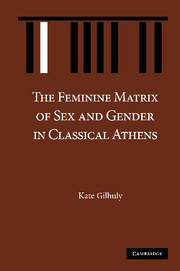Book contents
- Frontmatter
- Contents
- ACKNOWLEDGMENTS
- LIST OF ABBREVIATIONS
- 1 Introduction
- 2 Collapsing Order: Typologies of Women in the Speech “Against Neaira”
- 3 Why Is Diotima a Priestess? The Feminine Continuum in Plato's Symposium
- 4 Bringing the Polis Home: Private Performance and the Civic Gaze in Xenophon's Symposium
- 5 Sex and Sacrifice in Aristophanes' Lysistrata
- Conclusion
- BIBLIOGRAPHY
- INDEX LOCORUM
- SUBJECT INDEX
3 - Why Is Diotima a Priestess? The Feminine Continuum in Plato's Symposium
Published online by Cambridge University Press: 21 October 2009
- Frontmatter
- Contents
- ACKNOWLEDGMENTS
- LIST OF ABBREVIATIONS
- 1 Introduction
- 2 Collapsing Order: Typologies of Women in the Speech “Against Neaira”
- 3 Why Is Diotima a Priestess? The Feminine Continuum in Plato's Symposium
- 4 Bringing the Polis Home: Private Performance and the Civic Gaze in Xenophon's Symposium
- 5 Sex and Sacrifice in Aristophanes' Lysistrata
- Conclusion
- BIBLIOGRAPHY
- INDEX LOCORUM
- SUBJECT INDEX
Summary
INTRODUCTION: SYMPOSIA HIGH AND LOW
In the previous chapter we saw how one orator construed the proper ordering of the prostitute, wife, and priestess as a structure used to symbolize civic order, reflecting different temporal and moral dimensions of civic participation. The collapse of the differences between these identities figured a threat to the ethical and economic distinctions governing citizen behavior. To show that this construction of the feminine was not merely one orator's conception, but rather a pliable discourse that could operate in a variety of spheres, we must see it at work in a different context. In the following two chapters, I examine how the discursive formation of the prostitute, the wife, and the ritual agent operates in two versions of Socratic pederasty. First I will read Plato's Symposium, then Xenophon's. Both of these authors, I will argue, use this feminine hierarchy as a way to configure and justify particular elite practices.
From one vantage point, these two texts have diametrically opposing strategies in terms of their treatment of gender, and in particular the representation of women. For this reason an analysis of the feminine hierarchy in each text will show how the same discursive structure can be made to serve differing ends. Perhaps it is the primacy of bodily spectacle that has inspired the observation from so many commentators that Xenophon's Symposium is a work of realism.
- Type
- Chapter
- Information
- Publisher: Cambridge University PressPrint publication year: 2008



